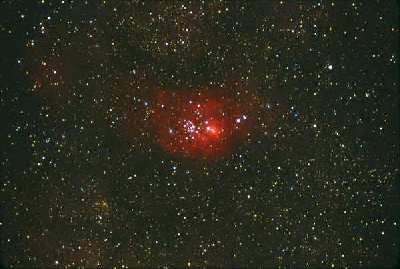
(Weekend Under The Stars)

Wednesday afternoon many of the Cheyenne folks had already set up Motorhome Row along the west edge of the south field. Apparently the journey up to Foxpark from Laramie was hindered by wind and hail which caused some sweat, damage, and a little blood, but nothing that was irrecoverable. Wednesday night's weather was continual rain and hail, which left deep puddles of standing water that persisted into Thursday afternoon.
Thursday around noon (after driving through a brief hail shower south of Laramie) I arrived to find the observing site already steadily filling with dark sky pilgrims seeking solace from the hazy, light polluted cities of Colorado's front range and elsewhere.

After setting up camp and dodging a few marauding thunderstorms, our luck ran out a couple of hours before sunset when we were pummeled by rain mixed with pea-sized hail which replenished the previous evening's remaining puddles. The moisture-soaked ground and trees would spell doom for many telescopes that succumbed to dew just after the setting sun's rainbow-illuminating rays retreated into the west. Shortly after dark we saw the space station pass through the northern sky, followed an hour later by an Iriduim flare.
The rest of the night yielded periods of good seeing and fair transparency depending on which part of the sky you were looking at, but roving patches of watery murk invisible to the naked eye, but starkly obvious in the telescope were enough to make most folks abandon their scopes in favor of roaming around the field and/or playing with binoculars, though several stayed up into the wee hours persevering to make the most of the time under a dark sky.
Though the air was very moist, the temperature stayed warm enough to leave the parka packed away, and gloves were not needed until just before midnight. I hit the sack about 1:30 a.m. and managed to get a rare (for a star party) six hours of sleep, awakening in the morning to find a white hoary frost covering the ground and 1/4 inch thick plates of ice floating in my solar shower, but the warming rays of the climbing sun and a mild west breeze soon cleared those sparkling reminders of impending autumn away.
In the space of a couple of short hours the morning's chill was replaced by a soft warm breeze that persisted through most of the day, with scattered thunderstorm seeds skirting across the sky and occaisionally blocking the sun. The afternoon brought out a few kites and young model rocket enthusiasts that passed the time chasing their descending rocket around the field. Late afternoon brought an apparent doubling of the population and a mirror grinding demonstration put on by volunteers taking turns walking around the barrel and pushing the glass, which became a fine ground f/7 mirror ready for polishing by Saturday afternoon.
A few hours before Friday's sunset the breeze had settled down to near zero and everyone made the most of enjoying what would surely be one of the few remaining summerlike evenings at this altitude remainging for the year - cloudless and beautiful. At 6:30 about 60 folks assembled for the pilgrimage up Jelm mountain where they were treated to views through the 92 inch f/27 telecope of Mars, the Cat's Eye nebula, the Little Gem (NGC6818), and the Saturn nebula which, from all reports, was the highlight of the show. I'm sorry I missed that view of the Saturn nebula, but I'm very glad I missed the reported 1 hour wait in line for each peek through the eyepiece. Having gotten a taste of what that scope can do last year, I am sure those that didn't have aperture fever before the trip returned with a severe case of the same.
Friday's mild sundown faded into a beautiful night sky that produced some fairly crisp views of Mars and great imaging opportunities.The dry air cooled rapidly and by 11:00 p.m. it was parka time. Slightly dewed surfaces rapidly became frosted.
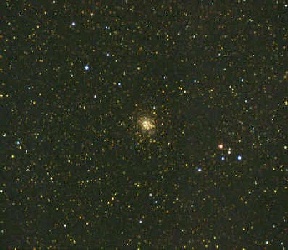

We were treated to a bright overhead passage of the space station, and at about ten minutes before eleven those of us that were facing south exclaimed loudly when we saw a beautiful bright meteor streak straight down through Sagittarius looking for all the world like it had hit the ground. It changed from an emerald green to a bright piercing yellow and seemed to fracture as it neared the horizon. I estimated it to be about four times as bright as Mars. Very nice! The folks that returned from the observatory on Jelm mountain around 1:30 or 2:00 a.m. said the light from that meteor lit up the inside of the dome. I want to see many more like that! The Jelm travelers also noted that the air temperature was much warmer on the mountain top than at Foxpark.
By about 2:00 a.m. the sky began to get murky to the point that I decided to cover up my scope, but by 2:30 or so things began clearing up again. At that point I was ready for some sack time so I hit the hay, though I heard the voices of many folks that stayed up to get their views of Saturn and Jupiter before the sun came up.
Saturday morning was cloudless and bright with a chilly breeze that kept the sunshine feeling good until early afternoon when folks tended to seek shade, but the heat was not bad and quite bearable in comparison to just a month ago. The swap meet was a little thin as usual for these past few years, but everyone had a great time hobnobbing and swapping observing tales and the like. Astrosystems had their booth set up for those that were in the market for various parts, accessories, books, and jewelry.
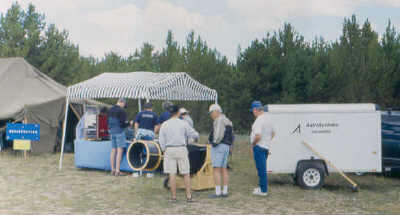
My favorite new home grown scope that I noticed this year was Marty Curran's new 10 inch Newtonian binoculars - very solidly built and a joy to use. Another item of note was Randy Cunningham's beautifully crafted wooden finder scope.
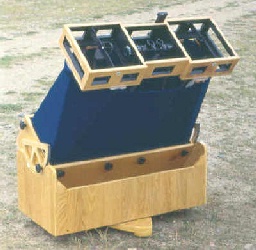
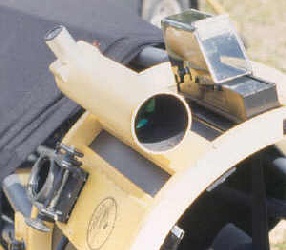
Late arrivals were still filing in during the afternoon's speaker's presentations which included an informative talk by Stephanie McLaughlin on NASA's upcoming Deep Impact mission to comet 9P//Tempel 1 during it's next visit to the inner solar system beginning in 2003. This project will attempt to impact a penetrator on the suface of the comet to create a 100 meter crater and determine the comet's composition by spectroscopy.
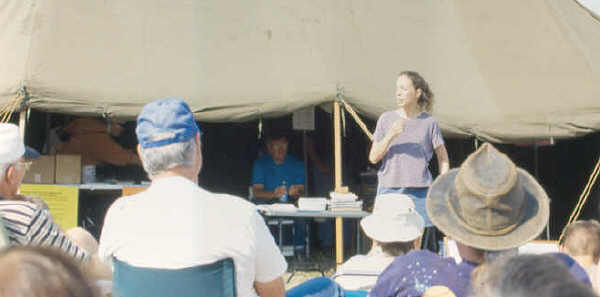
She also described the Small Telescope Science Program which coordinates the observations of advanced amateurs and student astronomers equiped and willing to obtain broadband VRI CCD images of the comet to be used in conjunction with the mission.
Next up was Allyn Smith of the University of Wyoming who gave a rundown of the methods, capabilities, goals, and impressive early results of the Sloan Digital Sky Survey. This project is truly one of history's greatest landmarks in the area of astronomical data acquisition. Allyn mentioned a figure in the hundgeds of terabytes of information. The positional and spectroscopic results that will be obtained with this amazing mine of data will surely change the cosmologist's views of the universe in dramatic ways in the coming years. Stay tuned.
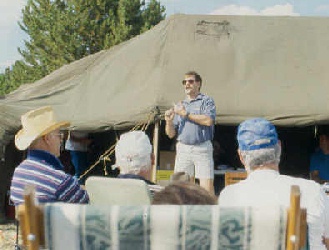
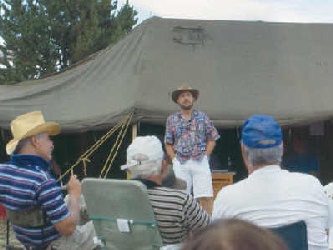
The last of the afternoon's speakers was Bruce Bookout(?) who gave a very interesting talk on archeoastronomy with particular emphasis on the astronomical architecture of the Mayan civilization.
Following the speakers, the always popular and well attended door prize giveaway resulted in a lot of smiles. Some of the booty included a couple of fancy eyepieces, a 6 inch mirror grinding kit, some deep sky filters, astro-software, dew shields, a set of nice sky guide books, some very nice gift certificates, and the ubiquitous posters, games, calendars, t-shirts, and other goodies. Good fun!

The evening began with wonderfully mild temperatures and a fairly cloudy sky, which did let us see a third passage of the space station at about 8:40. This was a unique passage too. As we watched the spacecraft pass into the east we were thrilled to see it suddenly brighten to several times it's typical level - MUCH brighter than any iridium flare I have ever seen. It made Venus's greatest brilliancy look dim in comparison. I am convinced that if it had been fully dark at the time it would easily have cast a dim shadow. Venus does. I'd venture to guess the total light from that reflecting point source to be near that of a half moon. It was theorized that the geometry involving the spacecraft's huge solar panels, the sun, and our location reached a serendipitous alignment that resulted in such a grand show.
As the evening progressed, the sky gradually cleared in stages as clumps of cloud drifted overhead. Views through the slow-moving sucker holes to the south were good, though with the amount and slow speed of the shifting cloud I predicted that it would be a long wait, so I returned to my corner of the north field, covered my scope and put away my eyepiece case, only to turn around and look up to a suddenly clear sky! At that point, in light of the effort I had expended the previous chilly evening at the guiding eyepiece, I decided to treat myself and spend the night relaxing and mooching views from the plethora of other telescopes in attendance. I had a blast doing it too! The evening was fairly warm, and I never had to break out the parka, though I did take a brief warm-up break in a friend's trailer around 2 a.m. The transparency was pretty good, but it never really kicked in until about 1 or 2 a.m. The seeing wasn't too bad either.
I spent much of the evening just sitting in my lawn chair and gazing into that gorgeous sky, watching the meteors and enjoying the views through my new eyeglasses and reveling in the newly in-focus sights I had not seen in years. For instance, I had no idea that the bright star at the westernmost corner of Capricorn's big triangle is a close naked eye double. Discovery!! :)
After a final quick peak at a swimmiing Saturn in Gary's 30 inch at about 3 a.m. I gave it up and headed back to my camp in the north field, where I found a surprising number of people still going strong, but fatigue was nipping at my heels so I cashed in my chips at 3:30 for six much-needed hours of sleep.
Sunday morning's weather was highlighted by a fairly chilly breeze and a patch of high thin cloud that took the power out of the sun's warming rays. I was shocked to see how many people had left already. By noon nearly everyone had gone. I was entertaining the thought of spending another night and being very leisurely about packing a few things up, when at about 1 in the afternoon a fast-moving thundershower pelted me with pea-sized hail. That, and two more quick rain showers that followed in the next couple of hours turned my mind toward home, so I bugged out at 3:30 leaving only a solitary car to gather Sunday evening's stellar photons. I always regret passing up the chance of a solitary night under a dark sky in the boonies like that, but I had gathered a good dose of starlight for the weekend already.
Some other nature observations: There was some suspicious looking high haze in the sky most of the day on Saturday, the texture of which reminded me of the forest fire smoke of last year's WUTS. I am inclined to beleive that the fires in the Meeker and Jackson areas were contributing to the grayness of the night sky again this year. I never saw one mosquito the entire weekend, though there were an unusual number of little flies that would bite right through your socks. They only attacked intermittently though and were really not much bother.
I didn't see any foxes this year, but then again, I've never seen so many ground squirrels there either...
All together, WUTS was another great success from my perspective. I didn't catch the final numbers, but I beleive there were around 250 registered guests that brought some 1300 diametrical inches of telescope aperture (excluding the WIRO 96 inch on Jelm, I beleive).
Once again, a big thank you to CAS, LASSO, and the U. of W. (WIRO/Jelm) for their part in successfully bringing about the highest major star party in the U.S. for the 11th consecutive year.